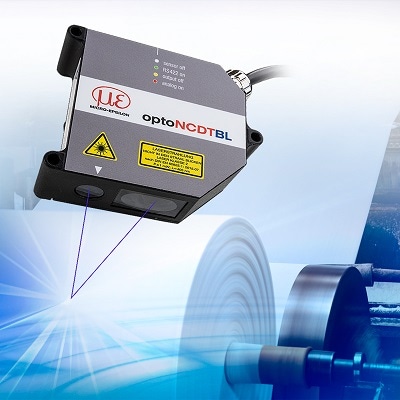Precision sensor manufacturer Micro-Epsilon has extended its optoNCDT 1750 range of laser triangulation sensors with a new Blue Laser version for high speed displacement, distance and position measurements. The sensors are equipped with new high performance lenses, laser control and evaluation algorithms to ensure precise measurements on different surfaces and materials.
 The optoNCDT 1750BL Blue Laser triangulation displacement sensor.
The optoNCDT 1750BL Blue Laser triangulation displacement sensor.
The optoNCDT 1750BL series of Blue Laser triangulation displacement sensors have an integrated controller and are available in several models with measuring ranges from 20 mm up to 750 mm. Patented by Micro-Epsilon, The Blue Laser technology offers decisive advantages compared to red-diode laser sensors. As the blue laser spot does not penetrate the surface, the target is sharply imaged onto the sensor receiving element. This enables high resolution measurements and reliable signal stability on shiny and translucent materials.
The measuring rate is continuously adjustable up to 7.5 kHz and can be individually adapted to suit each measurement task. Data output is via analogue or digital RS422 interface. Furthermore, the optoNCDT 1750BL provides two switching outputs that are controllable. Due to the Advanced Real Time Surface Compensation (A-RTSC) feature, the sensor operates almost regardless of the target material and colour. The exposure time or amount of light produced by the laser sensor is optimally matched to the reflection characteristics of the target surface, which enables reliable measurements even on difficult, changing surfaces.
New evaluation software algorithms and enhanced components provide even higher measurement accuracy and dynamics. High performance optics generate a small spot size onto the target, which enables very small objects to be measured accurately and reliably.
Based on an innovative web interface, the optoNCDT 1750BL is incredibly easy to use and set up without requiring any additional operating software. The settings for the measurement task can be quickly selected using application-specific, predefined presets. These are available to suit a wide variety of materials and surface types, including metals, plastics and organics. These presets enable rapid, straightforward set up and help to optimise the sensor for specific tasks.
When blue is good
While blue laser sensors were originally developed for the steel processing industry for use on red-hot glowing metals, as well as for automotive brake disc deformation testing and for measuring vibration on exhaust manifolds, other applications for blue laser sensors have since been discovered. When measuring on organic materials, foodstuffs, transparent or translucent materials (e.g. plastics), due to its shorter wavelength, blue laser light has a lower intensity and so penetrates significantly less into the surface than a red laser. Conventional red laser light penetrates more into the target material and is diffused there, resulting in a de-focused spot on the target surface. This results in a blurred spot being reflected back onto the detector, which means the sensor cannot define an exact distance. In contrast, the blue laser light does not penetrate into the target object due to its reduced wavelength and intensity. The blue laser produces a very small focused laser point on the surface, providing stable and precise measurement results.
Highly polished surfaces
Due to its shorter wavelength, blue laser sensors also perform better on highly polished or gloss surfaces. A red laser light is distorted by the shiny surface, resulting in a “speckle” effect. This produces increased signal noise on the detector and therefore a loss of measurement accuracy. In contrast, the shorter wavelength of the blue laser sensor performs extremely well with much less speckling, resulting in much lower noise levels, typically by a factor of two to three compared to red laser sensors.
2D/3D profile measurements
The advantages of triangulation using a blue laser light not only apply to one-dimensional measurements (i.e. distance, displacement, thickness and vibration) but also to multi-dimensional 2D and 3D inspection such as profile or contour measurements. Here, using blue laser sensors rather than red have opened up new measurement applications that were previously not possible using red laser sensors. Profile measurement of red-hot glowing metals, organic materials, foodstuffs, transparent and highly polished surfaces are best carried out using a blue laser profile sensor.
Source: http://www.micro-epsilon.co.uk